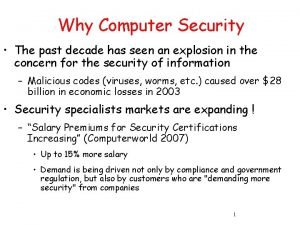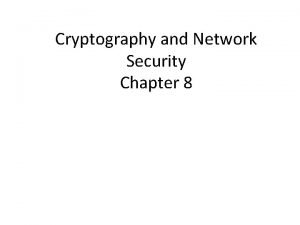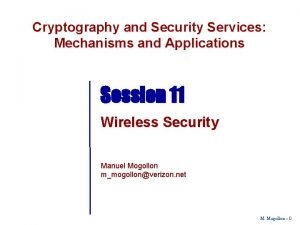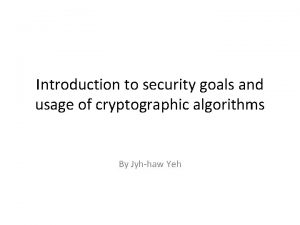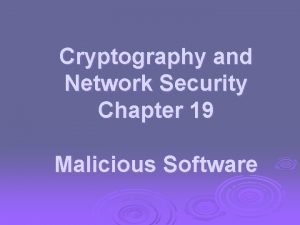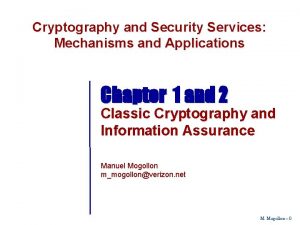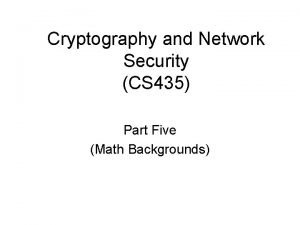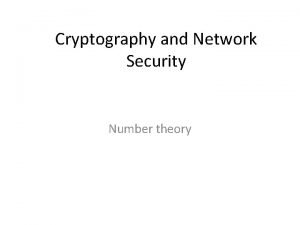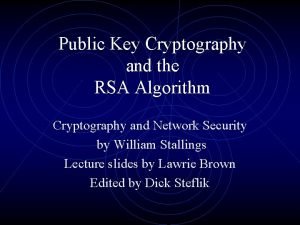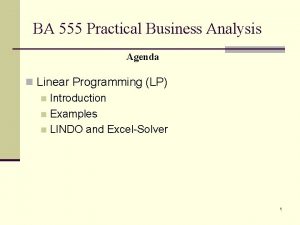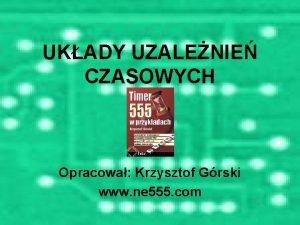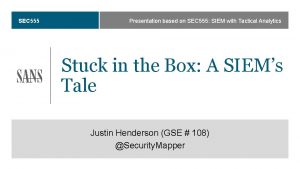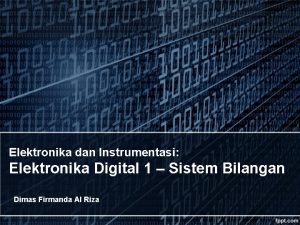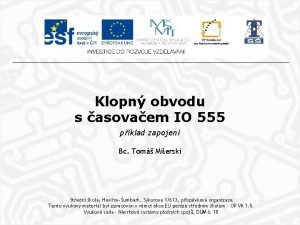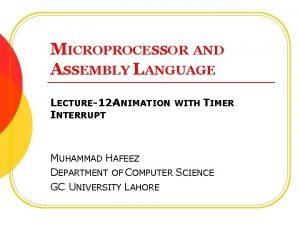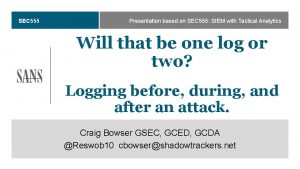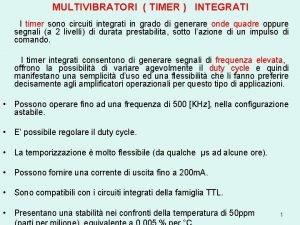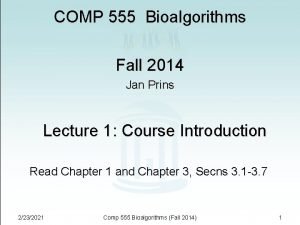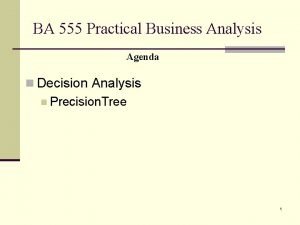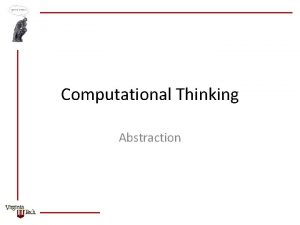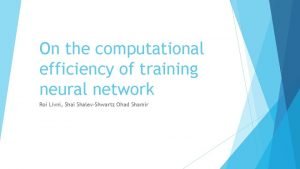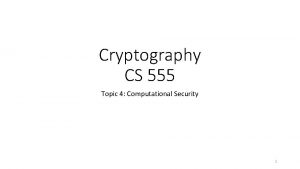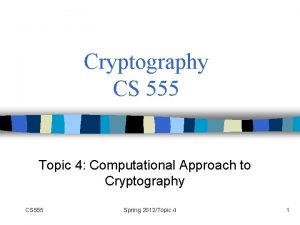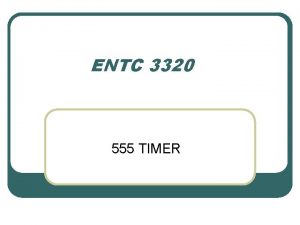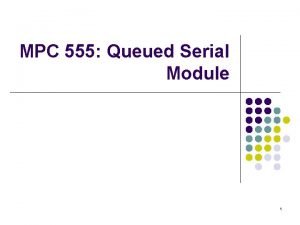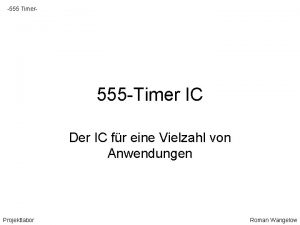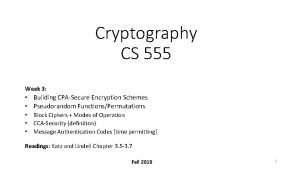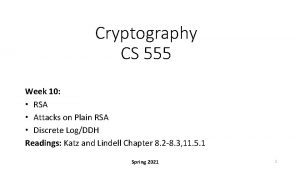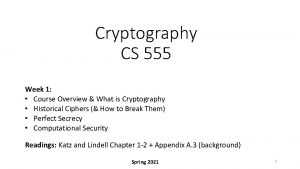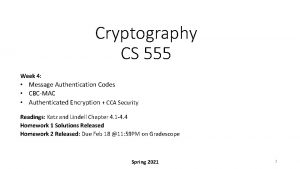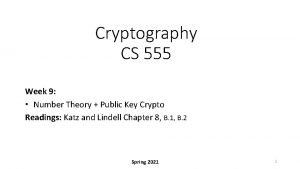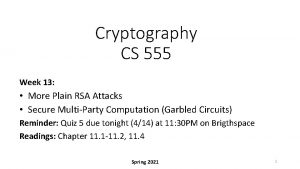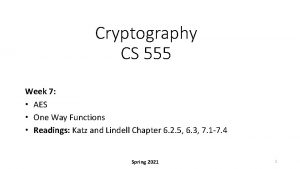Cryptography CS 555 Week 2 Computational Security against


















































































- Slides: 82

Cryptography CS 555 Week 2: • Computational Security against Eavesdropper • Constructing Secure Encryption Schemes against Eavesdropper • Chosen Plaintext Attacks and CPA-Security Readings: Katz and Lindell Chapter 3. 1 -3. 4 Fall 2018 1

Recap • Historical Ciphers (and their weaknesses) • Caesar Shift, Substitution, Vigenère • Three Equivalent Definitions of Perfect Secrecy • One-time-Pads 2

Principles of Modern Cryptography • Proofs of Security are critical • Iron-clad guarantee that attacker will not succeed (relative to definition/assumptions) • Experience: intuition is often misleading in cryptography • An “intuitively secure” scheme may actually be badly broken. • Before deploying in the real world • Consider definition/assumptions in security definition • Does the threat model capture the attackers true abilities? 3

Perfect Secrecy • 4

Perfect Secrecy • Would it be appropriate to use one time pads for message broadcast? (assume lifetime supply of one-time pads already exchanged) 5

Perfect Secrecy • Would it be appropriate to use one time pads for message routing on the internet? (assume lifetime supply of one-time pads already exchanged) 6

Week 2: Topic 1: Computational Security 7

Recap • 8

What if we want to send a longer message? K 1, K 2, K 3 9

What if we want to send many messages? K 1, K 2, K 3 10

Can we save their relationship? K 1, K 2, K 3 11

Perfect Secrecy vs Computational Security • 12

Current Goal • Define computational security in presence of eavesdropper who intercepts a single (long) message If you don’t understand what you want to achieve, how can you possibly know when (or if) you have achieved it? • Show to build a symmetric encryption scheme with computational security in the presence of an eavesdropper. • Define computational security against an active attacker who might modify the message • Define computational security for multiple messages in presence of an eavesdropper 13

Concrete Security “A scheme is (t, )-secure if every adversary running for time at most t succeeds in breaking the scheme with probability at most ” • Example: t = 260 CPU cycles • 9 years on a 4 GHz processor • < 1 minute on fastest supercomputer (in parallel) • Full formal definition needs to specify “break” • Important Metric in Practice • Caveat 1: difficult to provide/prove such precise statements • Caveat 2: hardware improves over time 14

Asymptotic Approach to Security • 15

Asymptotic Approach to Security • 16

Asymptotic Approach to Security • 17

Asymptotic Approach to Security • 18

Asymptotic Approach to Security Definition: An (randomized) algorithm A runs in polynomial time if there exists a polynomial p(. ) such that for every n-bit input x, A(x) terminates in at most p(n) steps in expectation. Intuition: If an algorithm A does not run in polynomial time then, for sufficiently large n, it will quickly become impractical for any attacker to run the algorithm A. 19

Asymptotic Approach to Security • 20

Advantages of Asymptotic Approach • Closure • If subroutine B runs in polynomial time and algorithm A makes poly(n) queries to the subroutine B then A also runs in polynomial time. • If f and g are negligible functions then h(n) = f(n)+g(n) is a negligible function • If p(. ) is a positive polynomial, and f(. ) is a negligible function the function g(n)=f(n)p(n) is also negligible. • Church-Turing Thesis: “reasonable” model of computations are all polynomially equivalent. • Implication: No need to worry about different models of computation (circuits, random access machines, etc…) • Disadvantage: Limited guidance on how big to make security parameter n in practice. 21

Private Key Encryption Syntax (Revisited) • Trusted Parties (e. g. , Alice and Bob) Requirement: all three algorithms run must run Gen in advance to obtain in probabilistic polynomial time secret k. 22

Private Key Encryption Syntax (Revisited) • Trusted Parties (e. g. , Alice and Bob) Requirement: all three algorithms run must run Gen in advance to obtain in probabilistic polynomial time secret k. 23

Adversarial Indistinguishability Experiment m 0, m 1 c b’ • Random bit b K Gen(1 n) c Enc. K(mb) 24

Adversarial Indistinguishability Experiment m 0, m 1 c b’ • Random bit b K = Gen(1 n) c = Enc. K(mb) 25

EAV-Secure m 0, m 1 c b’ • Random bit b K Gen(1 n) c Enc. K(mb) 26

m 0, m 1 c b’ • Random bit b K Gen(1 n) c = Enc. K(mb) 28

Aside: Message and Ciphertext Length • In the previous game we typically require that |m 0|=|m 1|. Why? • It is impossible to support arbitrary length messages while hiding all information about plaintext length • Limitation: When could message length be sensitive? • Numeric data (5 figure vs 6 figure salary) • Database Searches: number of records returned can reveal information about the query • Compressed Data: Short compressed string indicates that original plaintext has a lot of redundancy (e. g. , CRIME attack on session cookies in HTTPS) 29

Implications of Indistinguishability ith bit of message • 30

Semantic Security • 31

• A’ doesn’t even get to see an Example: h(m) background knowledge the encryption of m! Just the length Semantic Security f(m) = 1 if m > 100, 000; attacker might have about m. of m! f(m) = 0 otherwise . 32

Semantic Security • 33

Another Interpretation of Semantic Security • 34

Homework 1 Released • Due in class on Thursday, September 13 th (2 weeks) • Solutions should be typeset (preferably in Latex) • You may collaborate with classmates, but you must write up your own solution and you must understand this solution • Ask clarification questions on Piazza or during office hours 35

Week 2: Topic 2: Constructing Secure Encryption Schemes 36

Recap • Sematic Security/Indistinguishable Encryptions • Concrete vs Asymptotic Security • Negligible Functions • Probabilistic Polynomial Time Algorithm 37

Recap: EAV-Secure m 0, m 1 c b’ • Random bit b K Gen(1 n) c Enc. K(mb) 38

New Goal • Define computational security If you don’t understand what you want to achieve, how can you possibly know when (or if) you have achieved it? • Show to build a symmetric encryption scheme with semantic security. • Define computational security against an attacker who sees multiple ciphertexts or attempts to modify the ciphertexts 41

Building Blocks • Pseudorandom Generators • Stream Ciphers 42

Pseudorandom Generator (PRG) G • 43

PRG Security as a Game R b’ • 45


A Bad PRG • 47

One-Time-Pads + PRGs • 48

One-Time-Pads + PRGs • 49

Breaking Semantic Security m 0, m 1 Random bit b Random seed s b’ • 50

The Reduction PRG Attacker • Encryption Attacker b’’ R m 0, m 1 Random b’ g g = 1 if b”=b’ 0 otherwise 51

Analysis • 52

One-Time-Pads + PRGs • 53

Candidate PRG • 54

Stream Cipher vs PRG • 55

The RC 4 Stream Cipher • A proprietary cipher owned by RSA, designed by Ron Rivest in 1987. • Became public in 1994. • Simple and effective design. • Variable key size (typical 40 to 256 bits), • Output unbounded number of bytes. • Widely used (web SSL/TLS, wireless WEP). • Extensively studied, not a completely secure PRNG when used correctly, no known attacks exist • Newer Versions: RC 5 and RC 6 • Rijndael selected by NIST as AES in 2000 CS 555 Spring 2012/Topic 5 56

The RC 4 Cipher • The cipher internal state consists of • a 256 -byte array S, which contains a permutation of 0 to 255 • total number of possible states is 256! 21700 • two indexes: i, j i = j = 0 Loop i = (i + 1) (mod 256) j = (j + S[i]) (mod 256) swap(S[i], S[j]) output S[S[i] + S[j]] (mod 256) End Loop CS 555 Spring 2012/Topic 5 57

Limitations of Current Security Definition • 58

Limitations of Current Security Definition • 59

Multiple Message Eavesdropping Experiment (m 0, 1, …, m 0, t), (m 1, 1, …, m 1, t) (c 1, …, ct) b’ Random bit b K = Gen(. ) ci = Enc. K(mb, i) 60

Multiple Message Eavesdropping Experiment m 0, m 1 c b’ • Random bit b K = Gen(. ) c = Enc. K(mb) 61

Multiple vs Single Encryptions • 62

Example • 63

Multiple Message Eavesdropping Attack ), 0ℓ(�� )), m =(0ℓ(�� ), 1ℓ(�� )) m 0=(0ℓ(�� 1 b’ Random bit b s Gen(1 n) ci = Enc. K(mb, i) 64

Did We Cheat? • 65

Multiple Message Eavesdropping ), 0ℓ(�� )), m =(0ℓ(�� ), 1ℓ(�� )) m 0=(0ℓ(�� 1 b’ Random bit b s Gen(1 n) ci = Enc. K(mb, i) 66

Where to go from here? Option 1: Weaken the security definition so that attacker cannot request two encryptions of the same message. • Undesirable! • Example: Dataset in which many people have the last name “Smith” • We will actually want to strengthen the definition later… Option 2: Consider randomized encryption algorithms 67

Week 2: Topic 3: CPA-Security 68

Chosen-Plaintext Attacks • Model ability of adversary to control or influence what the honest parties encrypt. • During World War 2 the British placed mines at specific locations, knowing that the Germans, upon finding the mines, would encrypt the location and send them back to headquarters. The encrypted messages helped cryptanalysts at Bletchley Park to break the German encryption scheme. 71

Chosen-Plaintext Attacks • Model ability of adversary to control or influence what the honest parties encrypt. • Battle of Midway (WWII). US Navy cryptanalysts intercept and encrypted message which they are able to partially decode (May 1942). • The message stated that the Japanese were planning an attack on AF? • Cryptanalysts could not decode ciphertext fragment AF. • Best Guess: AF = “Midway Island. ” 72

Battle of Midway (WWII). • US Navy cryptanalysts intercept and encrypted message which they are able to partially decode (May 1942). • Message stated that the Japanese were planning a surpise attack on “AF” • Cryptanalysts could not decode ciphertext fragment AF. • Best Guess: AF = “Midway Island. ” • Washington believed Midway couldn’t possibly be the target. • Cryptanalysts then told forces at Midway to send a fake message “freshwater supplies low” • The Japanese intercepted and transmitted an encrypted message stating that “AF is low on water. ” 73

Battle of Midway (WWII). • US Navy cryptanalysts intercept and encrypted message which they are able to partially decode (May 1942). • Message stated that the Japanese were planning a surpise attack on “AF” • Cryptanalysts could not decode ciphertext fragment AF. • Best Guess: AF = “Midway Island. ” • Washington believed Midway couldn’t possibly be the target. • Cryptanalysts then told forces at Midway to send a fake message “freshwater supplies low” • The Japanese intercepted and transmitted an encrypted message stating that “AF is low on water. ” 74

Multiple Message Security and CPA-Attacks • Multiple Message Security • Attacker must select all messages at the same time. • Significant Limitation! • In the WWII attacks cryptanalysts selected the message adaptively • Selected message(s) to encrypt after observing target ciphertext 75

CPA-Security (Single Message) m 0, m 1 c = Enc. K(mb) m 2 c 2 = Enc. K(m 2) m 3 … b’ c 3 = Enc. K(m 3) Random bit b K Gen(1 n) 76

CPA-Security (Single Message) m 0, m 1 c = Enc. K(mb) m 2 c 2 = Enc. K(m 2) m 3 … b’ c 3 = Enc. K(m 3) Random bit b K = Gen(. ) 77

CPA-Security (Multiple Messages) m 0, 1, m 1, 1 c 1 = Enc. K(mb, 1) m 0, 2, m 1, 2 c 2 = Enc. K(mb, 2) m 0, 3, m 1, 3 … b’ c 3 = Enc. K(mb, 3) Random bit b K Gen(1 n) 78

CPA-Security (Multiple Messages) m 0, 1, m 1, 1 c 1 = Enc. K(mb, 1) m 0, 2, m 1, 2 c 2 = Enc. K(mb, 2) Challenge: Find concrete version of security c 3 = Enc. K(mb, 3) definition. m 0, 3, m 1, 3 … b’ Random bit b K Gen(1 n) 79

CPA-Security • 80

CPA-Security • CPA-security vs Multiple Message Encryption • CPA-security is stronger guarantee • Attacker can select messages adaptively • CPA-security: minimal security notion for a modern cryptosystem • Limitations of CPA-Security: Does not model and adversary who • Attempts to modify messages • Can get honest party to (partially) decrypt some messages 81

CPA-Security and Message Length • 82

Security Reduction • Step 1: Assume for contraction that we have a PPT attacker A that breaks CPA-Security. • Step 2: Construct a PPT distinguisher D which breaks PRF security. 83

Next Week • Read Katz and Lindell 3. 5 -3. 7 • Constructing CPA-Security with Pseudorandom Functions • Block Cipher Modes of Operation • CCA-Security (Chosen Ciphertext Attacks) 84

An Important Remark on Randomness • In our analysis we have made (and will continue to make) a key assumption: We have access to true “randomness” to generate a secret key K (e. g. OTP) • Independent Random Bits • Unbiased Coin flips • Radioactive decay? 85

In Practice • Hard to flip thousands/millions of coins • Mouse-movements/keys • Uniform bits? • Independent bits? • Use Randomness Extractors • As long as input has high entropy, we can extract (almost) uniform/independent bits • Hot research topic in theory 86

In Practice • Hard to flip thousands/millions of coins • Mouse-movements/keys • Customized Randomness Chip? 87

Caveat: Don’t do this! • Rand() in C stdlib. h is no good for cryptographic applications • Source of many real world flaws 88
 Wireless security in cryptography and network security
Wireless security in cryptography and network security Private security
Private security Computational security
Computational security Week by week plans for documenting children's development
Week by week plans for documenting children's development Intruders in cryptography
Intruders in cryptography Euler's theorem in cryptography and network security
Euler's theorem in cryptography and network security Cryptography security services
Cryptography security services Source
Source Introduction to cryptography and network security
Introduction to cryptography and network security Number theory in cryptography and network security
Number theory in cryptography and network security Dsa in network security
Dsa in network security Pigpen
Pigpen Malicious software in cryptography and network security
Malicious software in cryptography and network security Cryptography security services
Cryptography security services Cryptography and network security 4th edition
Cryptography and network security 4th edition Firewall base layer
Firewall base layer Modular arithmetic in cryptography and network security
Modular arithmetic in cryptography and network security Primitive root in cryptography and network security
Primitive root in cryptography and network security Modulo table
Modulo table Introduction to cryptography and network security
Introduction to cryptography and network security Fermat's theorem in cryptography and network security
Fermat's theorem in cryptography and network security Authentication in cryptography and network security
Authentication in cryptography and network security Pgp in cryptography and network security
Pgp in cryptography and network security Pearson cryptography and network security
Pearson cryptography and network security Cryptography and network security 6th edition pdf
Cryptography and network security 6th edition pdf Security mechanisms in cryptography
Security mechanisms in cryptography Rsa algorithm in cryptography and network security
Rsa algorithm in cryptography and network security Finite fields in cryptography and network security
Finite fields in cryptography and network security Carmine rizzo
Carmine rizzo Ba 555
Ba 555 Pwm 555 circuit
Pwm 555 circuit Lic bima bachat tax benefit
Lic bima bachat tax benefit Home and away 555
Home and away 555 555 timer metronome
555 timer metronome A 555-mile 5-hour plane trip
A 555-mile 5-hour plane trip Control voltage in 555 timer
Control voltage in 555 timer Distance time speed triangle
Distance time speed triangle Join and fork in activity diagram
Join and fork in activity diagram 555-0124
555-0124 Shop 555 ccc
Shop 555 ccc Tank oscillator
Tank oscillator Timer 555 w przykładach
Timer 555 w przykładach Nstm 555 2021
Nstm 555 2021 Schmittův klopný obvod s 555
Schmittův klopný obvod s 555 555 monostable circuit
555 monostable circuit 555
555 555 timer calculations
555 timer calculations Sec555
Sec555 555*24
555*24 Validation in se
Validation in se Circuito timer digital
Circuito timer digital Astabil multivibrátor 555
Astabil multivibrátor 555 555 timer pcb layout
555 timer pcb layout 444 555 666 888 33 88 artinya
444 555 666 888 33 88 artinya Io555
Io555 7 555
7 555 Vpn on 555
Vpn on 555 555 timer animation
555 timer animation 555 bistable multivibrator
555 bistable multivibrator Sec 555
Sec 555 Multivibratore monostabile
Multivibratore monostabile Monostabile 555
Monostabile 555 Multivibradores
Multivibradores Comp 555 unc
Comp 555 unc Ic 555 pin configuration
Ic 555 pin configuration Ba 555
Ba 555 816-555-0146
816-555-0146 816-555-0146
816-555-0146 Itäkeskus liityntäpysäköinti
Itäkeskus liityntäpysäköinti Explain about visa international security mode
Explain about visa international security mode Electronic mail security in network security
Electronic mail security in network security Seven touchpoints for software security
Seven touchpoints for software security Osi security architecture model
Osi security architecture model Nstissc model
Nstissc model Security guide to network security fundamentals
Security guide to network security fundamentals Guide to network security
Guide to network security E commerce security meaning
E commerce security meaning Security guide to network security fundamentals
Security guide to network security fundamentals Using mathematics and computational thinking
Using mathematics and computational thinking C6748 architecture supports
C6748 architecture supports Abstraction computational thinking
Abstraction computational thinking On the computational efficiency of training neural networks
On the computational efficiency of training neural networks Columbia computational linguistics
Columbia computational linguistics


